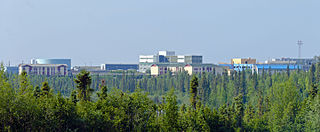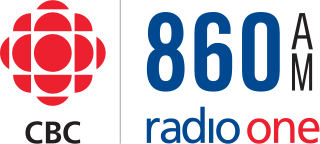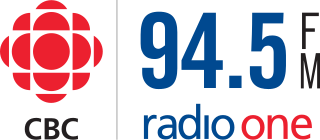Related Research Articles

Inuvik is the only town in the Inuvik Region, and the third largest community in Canada's Northwest Territories. Located in what is sometimes called the Beaufort Delta Region, it serves as its administrative and service centre and is home to federal, territorial, and Indigenous government offices, along with the regional hospital and airport.

Aklavik is a hamlet located in the Inuvik Region of the Northwest Territories, Canada. Until 1961, with a population over 1,500, the community served as the regional administrative centre for the territorial government.
CBXT-DT is a CBC Television station in Edmonton, Alberta, Canada. It is part of a twinstick with Ici Radio-Canada Télé station CBXFT-DT. Both stations share studios at the Edmonton City Centre in Downtown Edmonton, while CBXT-DT's transmitter is located on Wye Road in Sherwood Park.

Hay River, known as "the Hub of the North", is a town in the Northwest Territories, Canada, located on the south shore of Great Slave Lake, at the mouth of the Hay River. The town is separated into two sections, a new town and an old town with the Hay River/Merlyn Carter Airport between them. The town is in the South Slave Region, and along with Fort Smith, the town is home to one of the two regional offices.

Old Crow is a community in the Canadian territory of Yukon.
CBUFT-DT is an Ici Radio-Canada Télé station in Vancouver, British Columbia, Canada, which serves the province's Franco-Columbian population and Franco-Yukonnais in Yukon. It is part of a twinstick with CBC Television station CBUT-DT. Both stations share studios at the CBC Regional Broadcast Centre on Hamilton Street in downtown Vancouver, while CBUFT-DT's transmitter is located atop Mount Seymour in the district municipality of North Vancouver.
Northwestel Inc. is a Canadian telecommunications company that is the incumbent local exchange carrier (ILEC) and long-distance carrier in the territories of Yukon, the Northwest Territories, Nunavut, and part of Northern British Columbia. Originally established in 1979 by the Canadian National Railway from CN's northern telecommunications assets, it has been owned by BCE Inc. since 1988.

CBC North is the Canadian Broadcasting Corporation's radio and television service for the Northwest Territories, Nunavut, and Yukon of Northern Canada as well as Eeyou Istchee and Nunavik in the Nord-du-Québec region of Quebec.

CBR is a Canadian non-commercial public radio station in Calgary, Alberta. It broadcasts the programming of the CBC Radio One network, both on 1010 kHz on the AM dial and 99.1 MHz on the FM dial as CBR-FM-1. The studios are in the Parkdale neighbourhood of northwest Calgary.
CHFA-FM is a Canadian radio station, which broadcasts the programming of Radio-Canada's Ici Radio-Canada Première network in Edmonton, Alberta.

CFYK-FM is a Canadian radio station broadcasting at 98.9 MHz (FM) in Yellowknife, Northwest Territories. The station is owned by the Canadian Broadcasting Corporation and broadcasts national programming of the CBC Radio One network along with regional programs as part of CBC North.

The Canol Heritage Trail is a 350-kilometre-long (220 mi) trail running from Norman Wells, Northwest Territories, through the Mackenzie Mountains, to the Yukon border. Because of its remoteness, length and river crossings it is considered one of the most challenging trails in Canada. The trail is in the process of becoming a territorial park.

CKRW-FM is a hot adult contemporary radio station in Whitehorse, Yukon, Canada.

CHAK is a Canadian radio station, broadcasting at 860 AM in Inuvik, Northwest Territories. The station broadcasts the programming of the CBC Radio One network known as CBC North.
Digital terrestrial television in Canada is transmitted using the ATSC standard. Because Canada and the U.S. use the same standard and frequencies for channels, people near the Canada–United States border can watch digital television programming from television stations in either country where available. The ATSC standards are also used in Mexico, the Dominican Republic, Suriname, and South Korea.

CFWH-FM is a Canadian radio station broadcasting at 94.5 MHz FM in Whitehorse, Yukon. The station broadcasts the programming of the CBC Radio One network known as CBC North. Until its closure in 2012, CFWH's sister television station was CFWH-TV.

The Aboriginal Peoples Television Network is a Canadian specialty channel. Established in 1992 and maintained by governmental funding to broadcast in Canada's northern territories, APTN acquired a national broadcast licence in 1999. It airs and produces programs made by, for and about Indigenous peoples in Canada and the United States. Based in Winnipeg, Manitoba, it is the first network by and for North American indigenous peoples.
Northern Access Network was a Canadian unlicensed television system which broadcast videotaped programming to remote Canadian communities in the late 1970s. Although short-lived and often in conflict with the Canadian Radio-television and Telecommunications Commission over its lack of a broadcast license, the service did have the effect of forcing Canada's major commercial television networks to add rebroadcast transmitters in a number of communities they had previously ignored.
The Northern Messenger was a weekly radio programme broadcast to the Canadian Arctic. It functioned as a way to provide residents in remote locations with a means to communicate with friends and family in the south during the winter months when normal mail delivery was infrequent or non-existent and in an era before long-distance telephone networks had reached the region.
References
- ↑ "A HUNDRED YEARS OF MILITARY COMMUNICATIONS AND ELECTRONICS". C&E Museum. Retrieved 24 April 2017.
- ↑ Pigott, Peter (2011). From Far and Wide: A History of Canada's Arctic Sovereignty. Toronto: Dundurn Press. pp. 123–4. ISBN 9781554889891.
- ↑ "Parks Canada News Releases - Andy Mitchell Announces Heritage Designations" . Retrieved 7 May 2017.
- ↑ "Prince of Wales Northern Heritage Centre Historical Timeline of the Northwest Territories" . Retrieved 7 May 2017.
- ↑ Eyre, Kenneth (December 1987). "Forty Years of Military Activity in the Canadian North, 1947-87" (PDF). Arctic. 40 (4): 292–299. doi:10.14430/arctic1786 . Retrieved 7 May 2017.
- ↑ "History of the Northwest Territories Yukon and Radio System". WO1 Cal Vince. Retrieved 7 May 2017.
- ↑ Maclennon, Anne F. (2011). "Cultural Imperialism of the North? The Expansion of the CBC Northern Service and Community Radio". The Radio Journal – International Studies in Broadcast and Audio Media. 9 (1): 66–67.
- ↑ "NWT and Y History project - Stations". rcsigs.ca. Retrieved 24 April 2017.